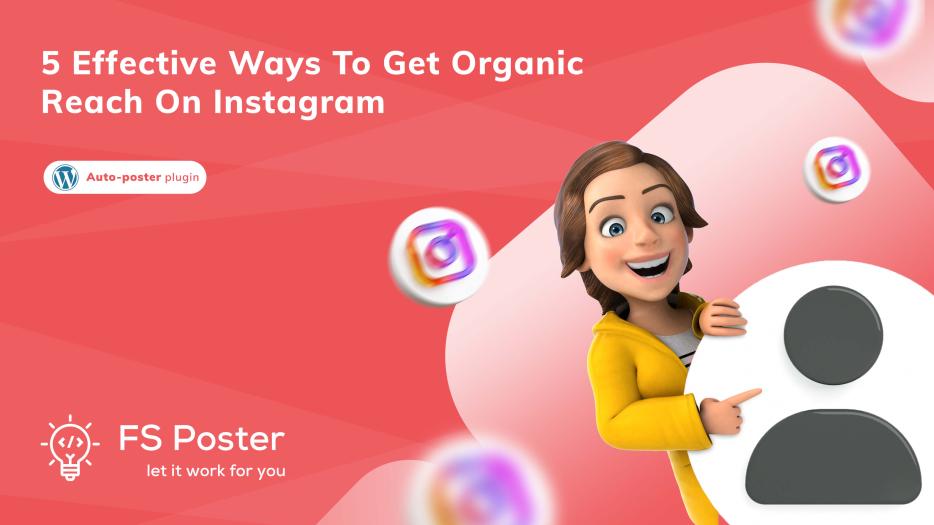
Aliyar Azimov
Author
Social media is a great tool that can help your business reach more potential customers and expand its online presence. You can publish expert content and engage with them too. But mastering the social media space isn't just easy. It takes research, strategizing and planning ahead.
Organic social media is an effective strategy for growing your social channels if you're willing to get creative about how you interact with your audience. Nowadays, all platforms have different algorithms and organic reach strategies. Still, growing your business organically and consistently with your target audiences can increase your business brand loyalty, improve customer care, boost SEO, get more followers, and much more.
But the question is: Where and how to start?
You may be publishing high-quality images on your social media channels, but all your followers are going by unnoticed. You’re not getting any conversions, shares, likes, or anything! Are you doing anything wrong?
This article will show 10 tips to increase organic social engagement and brand loyalty.
Let’s get started!
Build a complete social media strategy
There are tons of books and articles about social media strategy. As of today, many people and companies share their experiences with the audience about how to get good SEO results or social media engagement. But the most important fact is each piece of advice and recommendation is individual. It can also suit your business strategies, but these articles will not help you build a complete social media strategy in most cases.
You don't have to hire a professional team or invest massive money in your social media strategies, particularly at the beginning of the journey. Rather than publishing posts on the spur of the moment, it can help plan a posting schedule in advance. This will also help you find topics that resonate with your brand's target audience and match the overall social media landscape.

Analyze your competitors
When creating social media content for your company, it is essential to research what other companies in the same industry are posting. By doing this, you will have an understanding of what sort of content is booming. Once you've picked out a potential candidate to begin your search, you might be wondering:
- What are they posting?
- Which platforms are they posting on?
- What is the frequency of publishing posts?
- Which posts are trending, receiving a good amount of likes, comments, and shares? In which case is their engagement reasonably low?
By benchmarking your company with a similarly-sized competitor, you can gain insight into what is working and what isn't when it comes to your business strategy. This way, you can make informed decisions in the future.
Choose the proper social media channels
There's a multitude of social media platforms vying for our attention, and each has a different user base. But not all of them work the same way—or even at all—for every type of business. Some media platforms are designed specifically for companies in the healthcare sector, such as those partnered with an EHR Vendor, while others can be used across a variety of industries.
For instance, Instagram and Pinterest are designed for visual content. If your products are appearance-based, like clothing or home decor, then both of these channels should be important to the core of your strategy.
Keep in mind; there are many prominent social media channels from which you can benefit. But focusing on all of them can harm your energy and productivity. As a consequence, you can lose your brand reputation and customers.
It's essential not to overdo it. It's better to take the time to master one or two social media platforms and post engaging posts on them than it is to have a non-responsive strategy across all of them.

Optimize your profile
Once you have determined which social media platform is the best for your business strategies, you can now start optimizing your profile according to their requirements. Social media presence is essential to increase sales and growth. Make sure your company logo, business name, contact information, address, and URLs are correct and consistent with your business strategy. Do not forget to put brief explanatory details about your company on your social media page.
It would be best if you also looked at the messages & responses for each social networking platform. There are tons of plugins that allow you to build live chat features on your website. So, if your audience has questions, they can reach you through social media channels on your website and get the information more quickly.
Define your target audience
In theory, your target audience will always be the predetermined group of customers you want to sell to. However, social media provides the opportunity to widen your reach and expand your customer base by interacting with people outside of it.
What about reaching out to influencers in your industry and possible collaborators? This could also help increase brand recognition. Additionally, you might want to reach out to people who don’t necessarily have the same niche so that you can be seen as an authoritative source.
Plan who your audience is and what content they might be interested in.
Create a content plan
To get the most out of your social media account, it's essential to know who you're talking to. Make it consistent across all your social media accounts once you have a clear idea of the content. While creating a strategy, think about other possibilities than your usual content, whether your audience might be interested in it or not.
What information would you find the most useful to know about your business? In general, there are several elements that you should consider to create compelling content:
- High quality: Follow these guidelines that make sure your content sounds and looks professional to paint your brand in the best possible light.
- Relevancy: Make sure that your posts are relevant and make sense in the context of your business strategies.
- Visuals: Get creative and post new ideas on your business's social media that encourage readers to remember what you offer.
- Headlines: If you want your content to stand out on social media, an eye-catching headline is only one aspect. Your text should also be clear, concise, and enjoyable to attract more shares and likes.
- Hashtags: We recommend you use hashtags relevant to your industry and that have fewer posts.
- Collaborate with others: Post about others in your industry to grow your network and grab their audience.
Create a social media publishing schedule
Sharing your article on different social media channels is an integral part of your SEO strategy. We have a dedicated article about a monthly social media checklist explaining the leading strategies and steps to follow up to reach more people. If you haven't checked the article yet, take your pen and notepad as we provided the necessary information.
Here are a few social media timing strategies to boost your engagement on social media:
- Choose at least one slow period of the day: You should try to publish when fewer people are posting by checking social media analytics tools or just simply observing Facebook and Twitter. This will help you reduce the level of competition and find your voice easier.
- Post frequently: To build an engaged audience, you should post more often. Each platform has its own frequency on how often people should post, but as a minimum, most platforms advise that you post once per week.
- Be consistent: Try to post as often as you can and stay on top of your posting schedule. If you usually post daily but disappear for a week, your audience will quickly forget about you.
- Check when your audience is active: In the search for ways to stand out from competitors, it can be useful to see when your audience interacts with their content.
Define your social media goals
Today the success of new business companies depends on social media activities unless they don't decide to put a lot of investments on advertisements on different platforms. Social media marketing can have immense value for branding, but most businesses are not always sure about this value and don't know how to evaluate it.
A social media marketing goal is a declaration of your desire to accomplish through your marketing activities. You can set goals for everything from a single ad expense to a social media campaign. But keep in mind a social media goal is different from a social media marketing strategy though both are important for your business. In brief, social media goals are the blocks of your social media strategy. Each goal represents a different piece of direction which makes the complete strategy.
A social media strategy plan must include a list of all existing and planned social media accounts and specific goals for each platform. It means each account (if they represent a different niche and audience) must connect various social media objectives and the business's general digital marketing strategy. Good social media planning should define the roles and responsibilities within your team to reach more progress and be effective as much as possible.

React to comments and shares
One way to take part in social media is by being responsive & not just posting a message without following up on what they have asked. Would you ignore a customer who walks into your shop if they ask a question? Most probably, the answer is no! Ignoring a post on social media can lead to your company appearing uninterested in its customers or simply disorganized.
One good rule of thumb is to reply back to your comments and questions within 24 hours. When brands create an excellent customer service experience by responding to their customers, they build brand trust, which makes the company look more reliable. So, when you are receiving great customer service and a response time of fewer than 24 hours, your peace of mind is enhanced, knowing that you can count on the brand, to be honest with you. You're more likely to rank highly in the search engine when you are active on social media, leading to more traffic to your site.
Post the right balance of promotional and valuable content
It's challenging to find a healthy balance on social media because you want to push your brand, but you should also consider what other people would find relatable and beneficial. Users want to be able to access information that is relevant and helpful.
When you gain their trust, you can recommend paid products by advertising them to your audience. However, you have to keep the balance between promotional and organic posts. The golden rule is 80/20 balance. Eighty percent of your content should be valuable and helpful, while 20% can be promotional content of services or products.
Keep in mind, your original content (80%) will bring new followers and possible buyers. One excellent way to engage your target audience is to mix up the media types you use to promote your content. That might mean including a video or integrating images into your content.
Final Thoughts
One way to get a message out there on social media is to make sure it includes the right keywords to rank on search engines. Increasing your brand's organic social engagement can be tricky, but you'll find the best way to do it with some trial and error. If you start thinking about your social media work the same way as your SEO work, it will be easier to see their connection.
Whether working with influencers or running a contest, your focus should always be on honest engagement with your customers. The more relevant content you post, the higher your engagement rates will be, and you'll get better at social media marketing.










